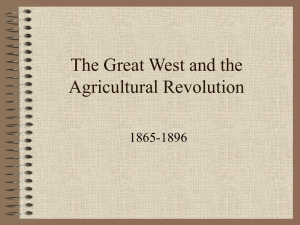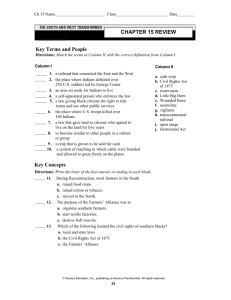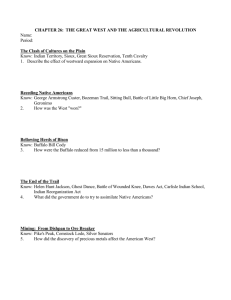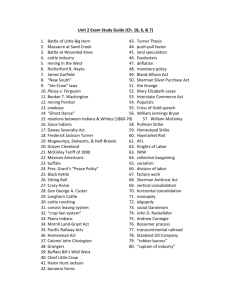Indian Wars and Resettlement
advertisement
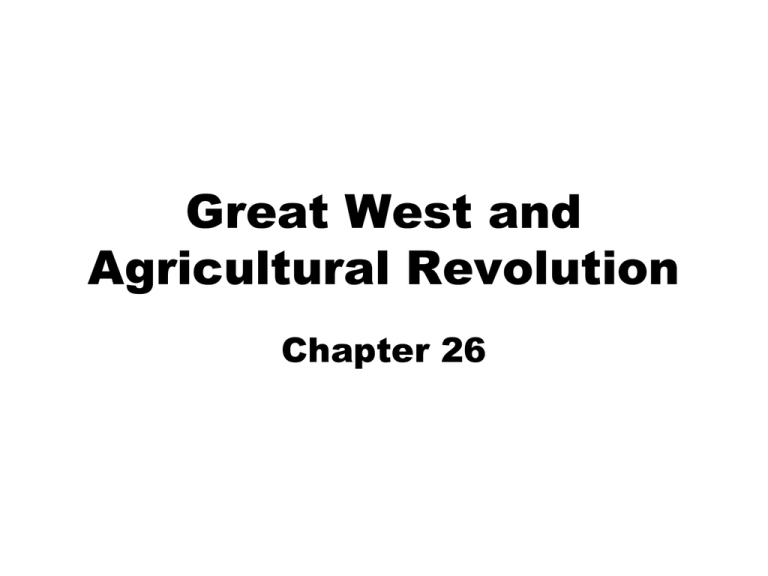
Great West and Agricultural Revolution Chapter 26 Indians of the Great Plains • • • • 360,000 North American Indians – Indians on Plains Relied on Buffalo – Were nomadic – Various tribes would fight between themselves • Those with access to horses had advantage White settlers began moving across Plains to get to Pacific – Some settled; brought small pox – Intentionally killed buffalo • Caused even more Indian wars over disappearing resources – Railroads played major role in ending Indian way of life Fort Laramie (1851) and Fort Atkinson (1853) Treaties – Established Indian territories separate from white settlement – beginning of reservation system – White treaties did not understand Indian culture, so were ineffective – In 1860s Indians pushed onto smaller territories (Dakota Territory, Indian (Oklahoma) Territory) Indians gave up land in exchange for security; but were taken advantage of The Cheyennes will have to be soundly whipped before they will be quiet. If any of them are caught in your vicinity kill them, as that is the only way. Colonel John Chivington, United States Army Indian Wars • • • • • Sand Creek Massacre • • Series of massacres by both US troops and Indians – Buffalo Soldiers – African American soldiers American policy became to either kill Indians or make them submit Sand Creek Massacre 1864 – Cheyenne and Arapaho Indians had a peace treaty with the US. – US Army attacked, killed and mutilated over 400 people Fetterman Massacre 1866 – Sioux Indians ambushed and killed US soldiers Battle of Little Big Horn (1876) – Gold discovered on Sioux reservation leading to white settlement – Custer’s Last Stand – Sioux led by Sitting Bull and Crazy Horse defeated US Army Chief Joseph (1877) – Led Nez Perce’s resistance Wounded Knee – US Soldiers killed unarmed Sioux when US military fought members of “Ghost Dance” Dawes Severalty Act • • Dawes Act 1887 • Attempt to Americanize and “civilize” the Indians • Aim to end Indian culture • Dissolved tribes and took away their land • Forced Indians to live on farms • Many Indians were scammed out of their land Carlisle Indian School (PA) • Created to convert Indians Gold Mining • • • • • 1849 – Gold in CA; “Fifty Niners” went for gold in Colorado and Nevada Pan mining (placer mining) – Take a tin, sift sand and gravel through and look for gold specks • Done mostly by individuals Hydraulic mining – High pressure water blasted into mountain to find gold Comstock Lode – was one of richest mines in world – Used Quartz Mining • Dynamite used to blast ore out of mountains Boom Towns – Virginia City – Develop overnight to provide food, supplies, entertainment, alcohol for miners – Frequently lawless, dominated by men – When gold runs out, everyone leaves and town becomes a ghost town Life on Range • Cattle roamed plains led by Cowboys – Cowboys learned skills from Mexican vaqueros – Needed open range for herds • Cattle Drives “Long Drive” – Ranchers paid cowboys to drive cattle from grazing areas to railroads from Texas to Wyoming (more money in east) – Needed to keep herd moving at consistent pace • Cow Towns (Abilene, Wichita, Dodge City KS) – Emerged at end of cattle drives – Frequently along railroad routes • End of Open Range – Too many ranchers reduced grasslands of Plains – Farmers began claiming lands in open range • Put up barbed wire fences to keep cattle out • Government helped protect land claims – Ranchers had to buy grazing land instead of open range • Cattle raising became a more structured business Farmers’ Frontier • • • • • • Railroad Land – Railroad companies were given land to sell in exchange for building railroads – Railroads encouraged settlement of west Homestead Act (1862) – Government gave 160 acres of land as long as work land for 5 years, improved it and paid $30 – Designed to encourage settlement, not raise money A lot of corruption in land sales Difficulties Farming – Prairie grasses were to break; required lots of labor – West of 100th meridian, water was difficult to find; weather extreme; insects – Barbed wire was invented to keep cattle off of farmland Dry Farming developed – Water wells were not enough for irrigation – “Dry farming” was developed • Used moisture in soil • Required steel plows and heavy machinery • Created conditions that led to “Dust Bowl” Federal irrigation projects brought water to area via dams West Grows • • • Great Plains grew rapidly – Helped with Homestead Act and railroads – CO, ND, SD, MT, WA, ID, WY, UT admitted between 18891896 Closing of the Frontier – 1889 Oklahoma was settled – ended the frontier – April 22, 1889 at noon the last Indian territory was settled by white settlers. • 9 hours – 2 million acres claimed – Best land taken by “Sooners” • People who entered the territory than the government allowed Frederick Jackson Turner (Turner’s Thesis) – American exceptionalism tied to frontier – Possibility of fresh start in west • West established new identity – Influenced by Hispanic, Asian, and Native American cultures – Environment played a bigger role Problems for Farmers • • • • Debt – Farmers to borrow money to buy food, clothing, and seed from stores. – Led to “big business” farming tied to markets and railroads Cash Crops – Farmers only grow cash crops such as tobacco, cotton, corn, wheat Low prices – caused by overproduction resulting in an increase in supply brought on by new land and machines. – Low prices led to less income to pay debt – Farmers lose money with bad crops or drops in prices More Expenses – High Tariffs increase cost of machines – Railroads could charge any price • Pools – competing railroads shared revenue in a market – railroads agree to charge farmers same rates • Rebates – Refund given to large businesses Farmer Response • • • • Farmers were at mercy of banks, railroads, nature, taxes – caused many small farmers to go bankrupt Grange – Founded by Oliver Kelley in 1867 • Originally was a social organization – Changes to a political organization • Farmers gathered and talked about their problems • led to calls for change – By 1875 800,000 members Cooperatives (Farmers Alliance) – Businesses, owned by groups of farmers, were created to buy and control resources – lowered prices because middleman was eliminated – Ignored tenant farmers and blacks Political Action – Farmers elect politicians that would support their needs • laws limited railroad and storage rates – Most success in IL, WI, IA, MN – Munn v Illinois (1877) allow state regulation of commerce Wabash v Illinois (1886) said states cannot regulate INTERstate trade – Greenback Labor Party won million votes in 1878 Coinage of Silver (Silverites) • • • • Populists attack Wall Street and “money trust” – Wanted nationalized railroads, telephone; income tax; government protection of farm prices Populists and farmers want gold AND silver to back money (bimetallist) – Would increase amount of money in circulation – Leads to inflation – supported by debtors – Farmers want inflation, so support Silver Free Silver Leaders – William Harvey Coin’s Financial School(1894) argued for coinage of silver – Mary E Lease “raise less corn and more Hell” Populists won many votes in 1892 forcing major parties to take notice of their issues Coxey’s Army and the Pullman Strike • • • Coxey’s Army (“Commonweal Army”) – Jacob Coxey led group of unemployed people to demand federal public works programs to relieve unemployment and printing of paper money Pullman Strike (1894) – Pullman made sleeper cars for trains • Pullman created a company town in which everything was owned by Pullman. – Panic of 1893/Depression of 1894 • Businesses lose money so cut wages to protect profit but didn’t lower rent of workers in company towns – American Railway Union led by Eugene V Debs • Debs led strikes and boycotts against poor treatment of workers by Pullman • Debs becomes leader of Socialist Party in America – Pullman put mail cars on each train to make stopping them a federal offense – President Cleveland send troops to stop strike Federal Government reaction created sympathy and increased radicalization of labor movement Conflict over money supply • Money Supply – Refers to the amount of money in circulation • Cheap Money (bimetallism) – more money leads to a rise in prices (inflation) • also known as cheap money – less money leads to lowering of prices (deflation) • Hard Money (Gold bugs, Gold Standard) – United States government backed every dollar with a certain amount of gold – Money supply limited because supply of gold is limited – prevents inflation – favored by creditors, businesses and Republicans Election of 1896 • William Jennings Bryan (Democrat) – Democrats opposed Cleveland because of his role in Pullman strike, hard money and Morgan bond deal – Bryan argued against the gold standard and the Populists supported him – “Cross of Gold” Speech – given at convention to inspire unlimited coinage of silver • William McKinley (Republican) – Supported big business and believed government should help big business • Wealth of laborers benefitted from strong business – McKinley argued coining silver would lead to factories closing and people losing their jobs – Supported gold standard and protective tariff – Trusts gave McKinley campaign large amounts of money to appeal to voters (outspent Democrats 16:1) Election of 1896 • McKinley Wins – Victory symbolizes strength of big business, urban, middle class values and financial conservatism over rural in politics – Last attempt by a politician to win with agriculture – Republican conservatives get control of Presidency for 16 years; ends period of reform • McKinley Presidency – Avoided reform and allowed trusts to operate without regulation – Tariff issue • Wilson-Gorman tariff was not raising enough revenue • Dingley Tariff Bill (1897) established high tariff rates – Economy improved which silenced money issue – New discoveries of gold “cheapened” its value
